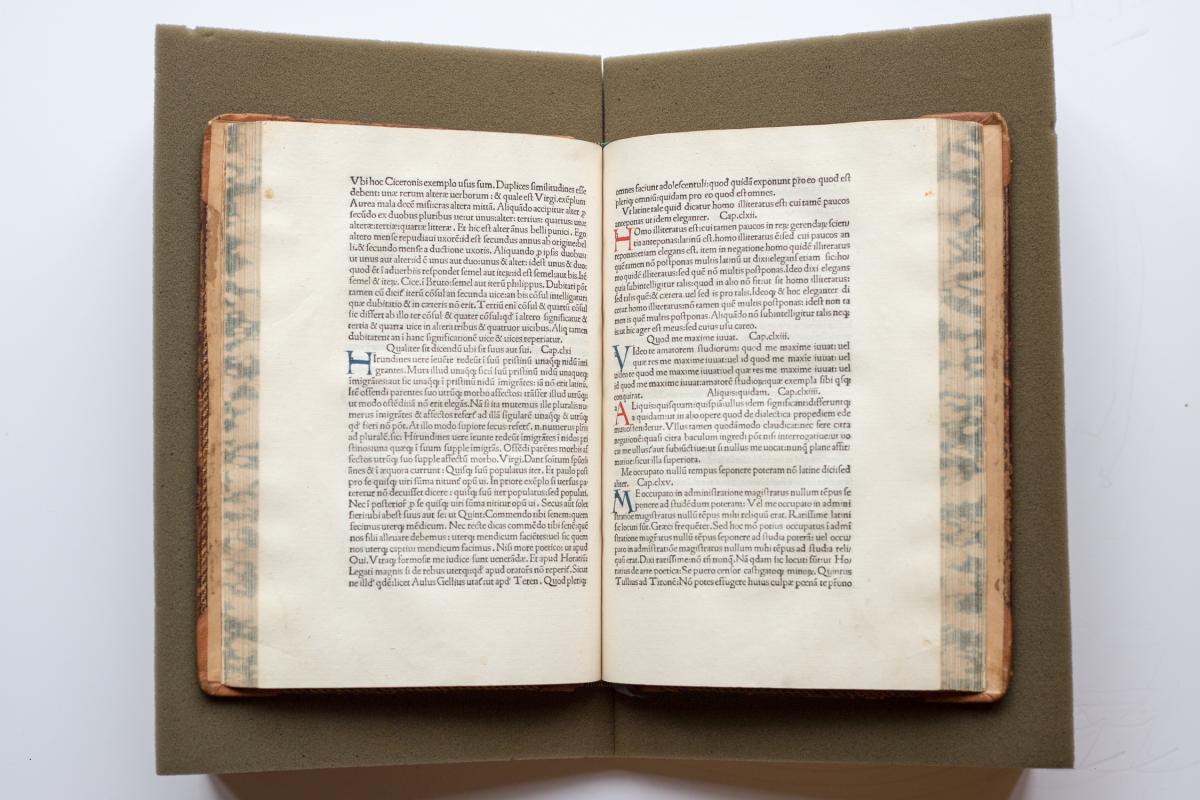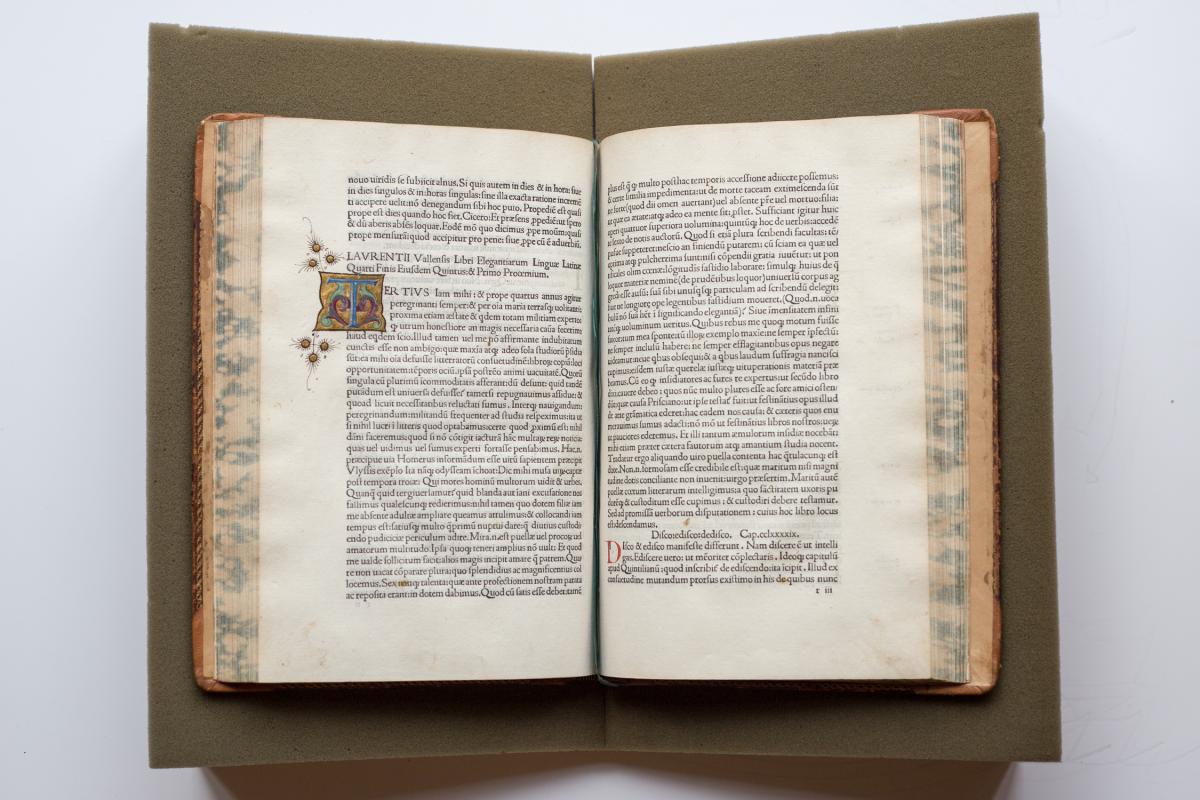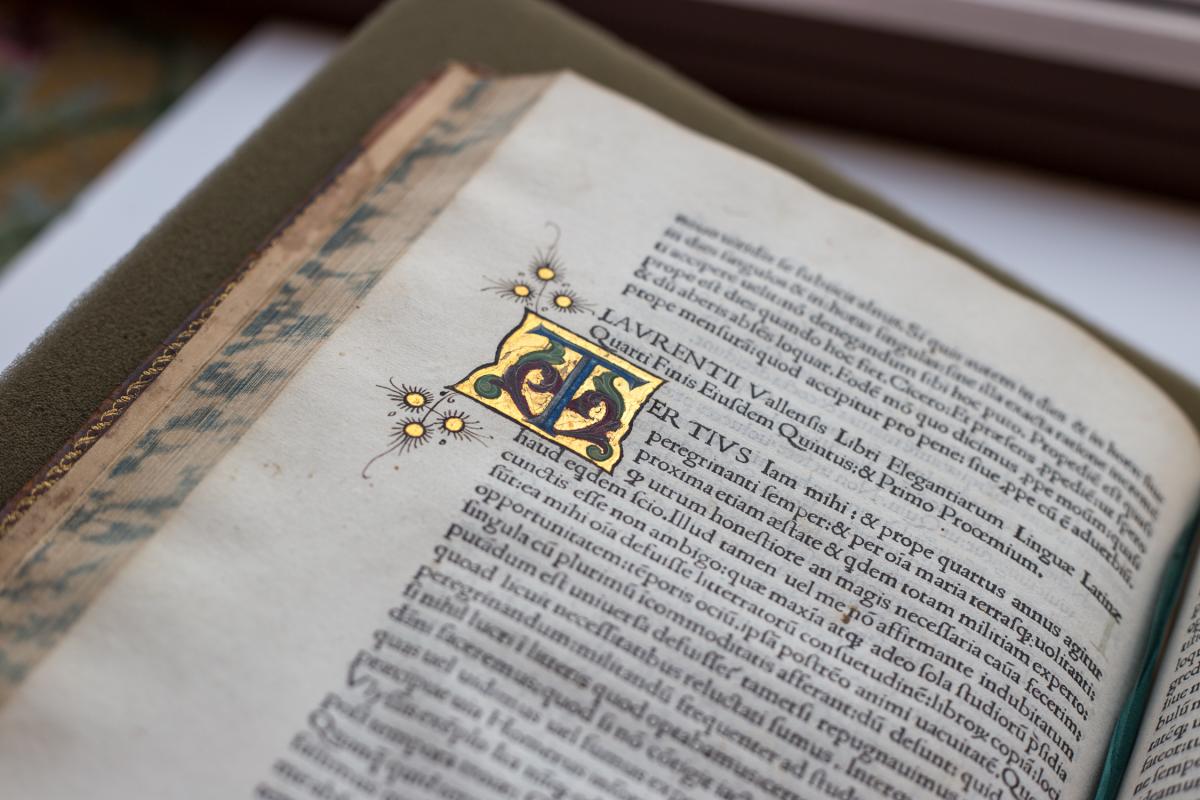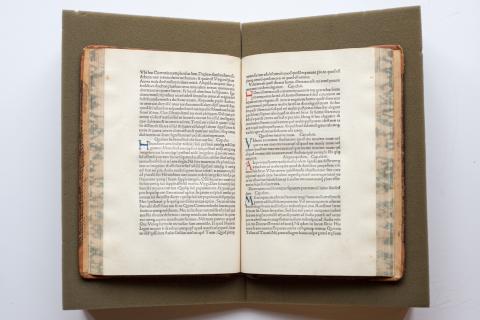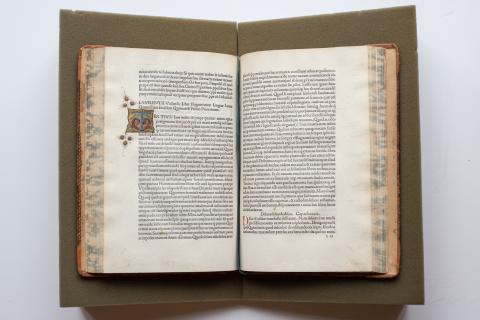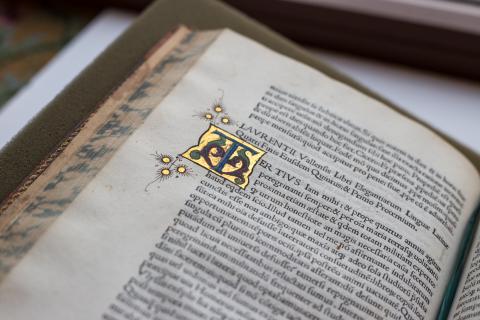Elegantiarum Linguae Latinae | The Beauties of the Latin Language
Elegantiarum Linguae Latinae | The Beauties of the Latin Language
Italian, 1480
Author: Valla, Lorenzo (Italian author, 1407-1457)
Celia Latz, Medieval Portland Senior Capstone Student, 2008
Lorenzo Valla wrote Elegantiarum Lingual Latinae in 1431 to advocate the importance of the correct usage of Latin. He believed Latin was the ideal and pure language for the expression of human experience and thought it was being altered and corrupted by misuse. The first printing was in 1480 and numerous re-printings of this incunable attest to its popularity through the sixteenth century. It is now maintained in the Wilson Rare Book Collection along with 8,000 other volumes that comprised the personal collection of John Wilson who was a successful Portland entrepreneur and a strong supporter of education. He donated his impressive collection to the Portland Public Library upon his death in 1900.
Books printed in the fifteenth century are incunables, a printing term that means swaddling clothes referring to the first infancy of printing. Books from this period are also referred to as "fifteeners". This particular volume had its upper and lower boards re-backed in the 19th century and the gold embossed diamond calf cover probably replaced the original cover in the 20th century. There are approximately 160 copies of this incunable accounted for in various international libraries.
The internal cover pages at the beginning and end of the book are of a hand-marbled paper typically used to bind books in the 1800s. It measures 11" by 8-1/2" by 1-1/4", making it a manageable size intended to be held in the readers' hands without the need for a podium. The paper is of excellent quality as it is still supple compared to the brittleness of the newer paper used for the cover pages in its restoration. The printer, Joannem Tortellum, used Roman case type derived from humanist cursive writing that was more clear and readable than the gothic type style of his contemporary colleague, Aldo Manutius. It was printed by the typographic method using individual pieces of cast metal movable type on a printing press made famous by Johann Gutenberg. The other method of printing at that time was xylographic which printed block books from a single carved wooden block for each page.
Each chapter begins with a hand-painted illumination in red, blue, and/or green ink, and gold that embellishes the first letter of the phrase. Some of the illuminations seem to have been re-touched with a heavy hand of paint covering the delicacy of the original work. The designs of the illuminations could have been inspired by the illuminist Leonardo Bellini who was related to Gentile and Giovanni Bellini, recognized by his elongated strokes ending in a delicate berry. Some of the designs in the Elegantiarum have similar wispy and flourishing strokes ending with a berry or bulb.
The watermark on the paper used to print this book is barely discernable. It is a simple design of an oval containing two obelisks with vertical lines down the centers. The paper could possibly be Fabriano, produced in Padova. Watermarks identify the manufacturer of the paper and are emblems incorporated into the paper by drying the sheets over a base of fine parallel wires. As the water-soaked paper dries on the grid, the lines and emblem are permanently impressed.
There are hand-written annotations in many margins which have unfortunately been trimmed, eliminating some of the writing. Sometimes these annotations were written by the author in their personal copies. Hand-writing, probably by John Wilson, is on the front leaf that was added after the re-binding in the 1900s. The annotations in this edition of Elegantiarum cannot be by the author, Lorenzo Valla, as he died twenty-three years before it was printed.
Fifteenth-century Venice attracted artists and intellectuals from different countries providing abundant material and ideas for publications, but perhaps this is not the main reason Venice became the main European printing center. Venice was above all a mercantile town where merchants came to do business and distribute their products to the widest public. Printing presses proliferated there most likely for the strategic and attractive mercantile position that only Venice offered.
Lorenzo Valla was a well-known expert in Latin and his writing proved to be a commercially successful endeavor for the publishers' business. He was born in Rome (1407-1457) and educated in Greek and Latin. He excelled in both languages and became influential through his many translations of Greek and Latin literature. He was perhaps the first critic who analyzed and corrected the New Testament by comparing manuscripts. In 1440 he wrote a pamphlet, Declamatio which disproved the "Donation of Constantine": a lie invented by the Catholic Church to take possession of Eastern territory. The revelation of the lie due to Valla's keen knowledge of Latin was so controversial that in 1444 he was brought to trial by the Inquisition but was able to escape their grip with a sarcastic proclamation of loyalty to the Church and the intervention of King Alfonso. After this episode, Pope Nicolas V invited Valla to Rome to occupy the post of Apostolic writer, paid him a large salary, and excused Valla's questionable allegiance to Church ideals because of the purity of Vallas' Latin style outweighed the humanist Pope's concerns.
The title, Elegantiarum Linguae Latinae, (The Beauties of the Latin Language), is not printed on the title page of this edition and there is no pagination. This is not unusual for a book of this period. Later, during a period of crisis in the printing press industry, title pages were found to capture the attention of potential buyers and were consequentially added more frequently to facilitate sales and marketing of books. The crisis was due to over-production and an excessive number of printing presses in Venice. In 1473 there were at least fifty-six printers producing quantities of publications that didn't correspond to the demands of the market.
Latin hasn't become the popular language that Valla advocated but Elegantiarum Linguae Latinae was reprinted in Venice again in 1568 by Scotus, one of the more famous printers, this time with a title page. It was considered to be a profitable product worthy of the printers' and publishers' investment. The evolving sales and marketing skills of the Venetian merchants probably played an important role in the distribution and popularity of this book and many like it.
Bibliography
Bernstein, Jane, Print Culture and Music in Sixteenth-Century Venice, (U.S.A. 2001); Oxford University Press
Buhler, Curt, The Fifteenth-Century Book, (Philadelphia 1960); University of Pennsylvania Press
Davies, Martin, Incunabula Studies in Fifteenth-Century Printed Books, (London 1999); The British Library
Davies, Martin, Aldus Manutius: Printer and Publisher of Renaissance Venice, (U.S.A. 1999); Arizona Center for Medieval and Renaissance Studies
Encyclopedia Brittanica Eleventh Edition, article "Lorenzo Valla", public domain
Herzop-Hauck, Realencyklopedie, Band xx, (Leipzig, 1908)
Wildschut, De vita et scriptes L. Vallae, (Leiden, 1830); p. 648
Suggested Reading:
- Mancini, G., Vita di Lorenzo Valla, (Florence, 1891)
- Symonds, JA, Renaissance in Italy, (1897-99)

